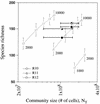Empirical and theoretical bacterial diversity in four Arizona soils
- PMID: 12039765
- PMCID: PMC123964
- DOI: 10.1128/AEM.68.6.3035-3045.2002
Empirical and theoretical bacterial diversity in four Arizona soils
Abstract
Understanding patterns of biodiversity in microbial communities is severely constrained by the difficulty of adequately sampling these complex systems. We illustrate the problem with empirical data from small surveys (200-member 16S rRNA gene clone libraries) of four bacterial soil communities from two locations in Arizona. Among the four surveys, nearly 500 species-level groups ( Dunbar et al., Appl. Environ. Microbiol. 65:662-1669, 1999) and 21 bacterial divisions were documented, including four new candidate divisions provisionally designated SC1, SC2, SC3, and SC4. We devised a simple approach to constructing theoretical null models of bacterial species abundance. These null models provide, for the first time, detailed descriptions of soil bacterial community structure that can be used to guide experimental design. Models based on a lognormal distribution were consistent with the observed sizes of the four communities and the richness of the clone surveys. Predictions from the models showed that the species richness of small surveys from complex communities is reproducible, whereas the species composition is not. By using the models, we can now estimate the required survey scale to document specified fractions of community diversity. For example, documentation of half the species in each model community would require surveys of 16,284 to 44,000 individuals. However, quantitative comparisons of half the species in two communities would require surveys at least 10-fold larger for each community.
Figures






References
-
- Chao, A. 1987. Estimating the population size for capture-recapture data with unequal catchability. Biometrics 43:783-791. - PubMed
-
- Chao, A. 1984. Nonparametric estimation of the number of classes in a population. Scand. J. Stat. 11:265-270.
-
- Cobb, N. S., S. Mopper, C. A. Gehring, M. Caouette, K. M. Christensen, and T. G. Whitham. 1997. Increased moth herbivory associated with environmental stress of pinyon pine at local and regional levels. Oecologia 109:389-397. - PubMed
-
- Colwell, R. K., and J. A. Coddington. 1994. Estimating terrestrial biodiversity through extrapolation. Phil. Trans. R. Soc. London 345:101-118. - PubMed
Publication types
MeSH terms
LinkOut - more resources
Full Text Sources
Other Literature Sources
Molecular Biology Databases
Miscellaneous

